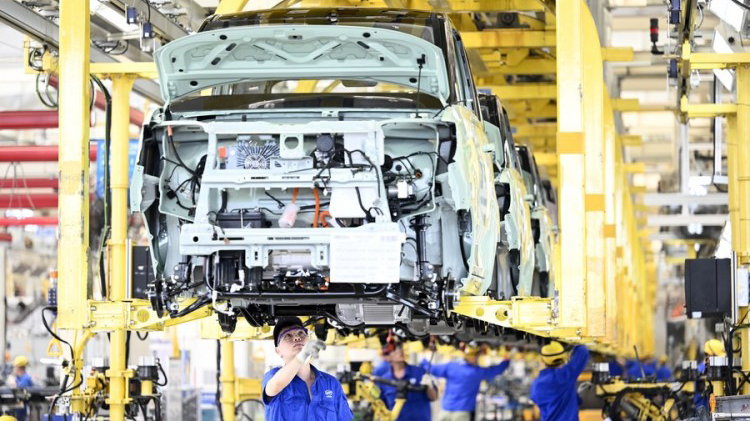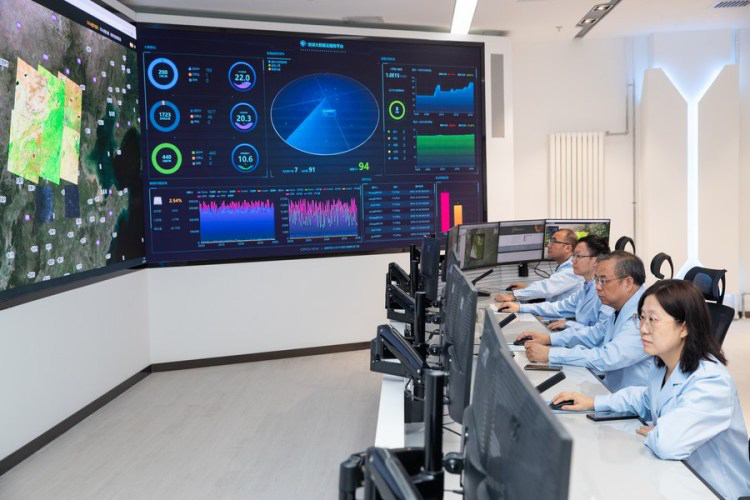
A production line of new energy vehicle at an automobile company in Liuzhou, south China's Guangxi Zhuang Autonomous Region, August 12, 2021. /Xinhua
A production line of new energy vehicle at an automobile company in Liuzhou, south China's Guangxi Zhuang Autonomous Region, August 12, 2021. /Xinhua
Editor's note: Noting that 2023 is the first year for fully implementing the guiding principles from the 20th National Congress of the Communist Party of China, the approaching "Two Sessions" will grab the world's attention. To better understand China's development blueprint, CGTN has curated the "Towards China's Modernization" series, and this is the third piece. John Ross, a former director of economic and business policy for the mayor of London, is a senior fellow at the Chongyang Institute for Financial Studies, Renmin University of China. The article reflects the author's opinions and not necessarily the views of CGTN.
China has set clear goals for its economic development not only in 2023 but in the long term outlook, for the next 12 years to 2035. For this year, the key issue is by how much China's economy will accelerate from the 3 percent achieved in 2022.
This is significant globally, since the U.S. and European economies are projected by the International Monetary Fund to slow down from their growth rate in 2022. Accordingly, global economic prospects for this year is dominated by how much the U.S. and EU will decelerate or will there be a recession or just slow growth, whereas on China the debate is about how much its economy will speed up.
But China has also set specific goals for the period up to 2035. At the 20th National Congress of the Communist Party of China, held last year, one of China's development objectives by 2035 was set as "substantially growing the per capita GDP to be on par with that of a mid-level developed country."
As China accounts for almost 18 percent of the world's population, and existing developed economies for 16 percent, this means China would include more people living in high income economies by the World Bank criteria than the rest of the world combined. Slightly earlier, the target of promoting high-quality development was set out in November 2020 by Chinese President Xi Jinping in a discussion on the 14th Five Year Plan, which concluded that by 2035, it is "completely possible" to double the total economic volume or per capita income.
But how can this be achieved? As the recent annual growth of China's population on the mainland has been nearly zero, it seems that the doubling of China's GDP by 2035 will not come from an increase in its labor force, but by boosting labor productivity. So, how can China achieve that?
The answer lies in strong technological and the high-quality development of China's economy. China's innovation is huge with rapidly increasing Research and Development (R&D) expenditure.
China's total R&D expenditure is already close to the U.S. in terms of total expenditure and could soon overtake it. As recently as 2000, China's R&D expenditure was only 11 percent of the U.S. By 2020, the latest internationally comparable data OECD data shows that China's R&D expenditure was 85 percent of the U.S. and growing almost three times as fast as that of the U.S. Over the last 10 years China's annual R&D spending grew an average 11 percent a year compared to the U.S.'s 4 percent.
Accordingly, China's total R&D expenditure could overtake the U.S. in 2023 or 2024, as recent U.S. reports admit, and by 2030 it would be almost 50 percent higher than the U.S.
To have an economic effect, it's a misunderstanding to believe innovation can remain at the level of ideas or abstract discoveries. It must be embodied in new production processes, new products, new machinery etc. This requires huge quantities of capital investment – the power of the most advanced U.S. high technology companies, Intel, Google, Microsoft etc, lies in this combination of R&D with huge capital investment.

A view of the International Research Center of Big Data for Sustainable Development Goals in Beijing, capital of China, September 8, 2021. /Xinhua
A view of the International Research Center of Big Data for Sustainable Development Goals in Beijing, capital of China, September 8, 2021. /Xinhua
The strengthening of China's companies in this can be seen in their international growth compared to other countries. In the Fortune 500 list of the world's largest international companies, in 2020, China for the first time had the most companies of any country, and by 2022, these companies achieved the highest combined revenues of any country.
The power of China's high technology development was first seen in the growth of companies such as Huawei – which is the world's most advanced telecommunications manufacturer. But it's spreading into a much wider range of industries. TikTok has become the world's most visited website – promoting China's development in consumer industries.
Additionally, a study published by Harvard University in October last year, "How China is Winning the Race for Clean Energy Technology," concluded: "China has harnessed its competitive advantage in policy consistency and lower-cost capital to lead the market in solar, wind, and EV technology… China is a veritable green power. It leads the world in renewable energy production figures and is the world's largest producer of wind and solar energy, as well as the largest domestic and outbound investor in renewable energy… China had surpassed the U.S. by the late 2000s and Europe by 2012 to be the world leader in low carbon technology investment, pumping in annually at least $100 billion into innovation by 2014. As of 2018, Chinese investment in clean energy technology was almost double that of the U.S."
It is this combination of R&D created innovation and capital investment, which creates the high technology/high value added dynamic for China's economy. China's capital creation for investment now exceeds the U.S. According to World Bank data, China's annual capital creation – the total savings by companies and individuals – has reached $6.6 trillion compared to the U.S.'s $3.8 trillion. China therefore has unequalled ability to finance rapid embodiment of innovation in new high value productive capacity.
China has the world's leading companies from banking, energy and materials, its original strong points, into areas of high technology such as telecommunications, consumer products, and clear energy production. This combination ensures that China will achieve high-quality development.
(If you want to contribute and have specific expertise, please contact us at opinions@cgtn.com. Follow @thouse_opinions on Twitter to discover the latest commentaries in the CGTN Opinion Section.)